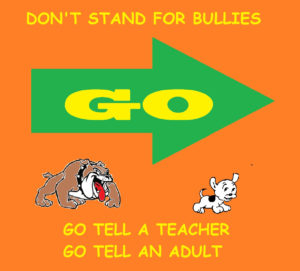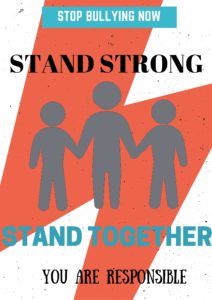Intervention
By: Anna Burns, Katrena Gillis, Eric Olsen, and Marial Williams
The landscape of bullying has really begun to evolve over recent years, with more traumatic stories of children’s mistreatment by their peers popping up all over the news. Bullying was once given little thought, but has been thrust into the bright spotlight, riddled with stories of child suicide swirling about. While bullying may not be one hundred percent preventable, there are preventative actions that can thwart the current onslaught of bullying. Intervention is the answer, stopping both current bullying and inhibiting its spread.
When it comes to bullying, intervention is essentially coming between the bully and the bullied to end their negative relationship to one another and to keep future bullying from happening. There are many different ways to intervene, and intervention techniques can vary depending on the intervening individual and the type of bullying that is being addressed. When digging deeper into strategies to implement to promote intervention there are several ideas to realize. Several pro-intervention programs are trying to be implemented, but some have a tendency to be short-sighted and are more of a blanket approach aimed at helping the majority of bullying situations. This causes numerous instances of bullying to continue without the proper help. Bullying is also a changing subject that can no longer be pinned to a couple of methods like name calling. Especially with the growth of the internet and social media bullying has grown to take on many new forms. Our society at large also needs to realize the vital role that everyone plays in combating bullying. The struggle is no longer on the shoulders of the victims alone, but all people need to discover that they have influence and can decrease the amount of future bullying.
A variety of tactics could change the setting of bullying for the better. Specifically a feminist social justice approach – a full societal overhaul – would empower more people to see the causes of bullying around them. Fundamentally, people would think differently in bullying situations, rather than relying on male-centered ethics like the current norm. In fact, much of today’s bullying stems from young boys trying to assert their masculinity over each other. If society changed the environment males grow up in, a lot of this bullying would be stopped. Individuals would handle situations in a far different frame of mind, resulting in a much more pro-active approach to managing bullying. People would be better equipped at analyzing situations before acting, thus being better at weighing outcomes, and therefore would be less likely to engage in bullying.
One of the most important things to realize when dealing with bullying today is that there are many programs already in place set to deal with bullying. Unfortunately, as films such as, “Bully” show, the administration that oversees bullying incidents either acts inappropriately toward resolving the conflict or does not hear about the instance. The administration in some situations make the bullying worse than before, leaving the victims with fewer options than before. This is where it is important to know that everyone plays a part in the fight against bullying. Parents need to take initiative with their children’s administration if they feel that the administration’s intervention is not working. Administration’s failure to promote intervention in bullying happening within their domain is preventable, and parents, students, and society should take the necessary steps to cease ongoing bullying.
In the readings, Pascoe talked about homophobic bullying and how society’s views of gender identities has played a large part in creating a mentality that anyone who does not fit the identity has a problem. Boys who do not have enough masculinity in their classmate’s eyes may be bullied for being feminine. If society would see feminine qualities as equal to masculine qualities, a lot of this type of bullying would go away.
Michel Foucault also talks about society’s views in saying that society creates what is normal and abnormal. Part of society’s view of normal is the white heterosexual male. This is definitely not a category that everyone fits into, and that is a cause of nearly every type of bullying of those who are considered different. It would help stop bullying if society would stop labeling things as normal and abnormal, and if society would stop seeing “abnormal” as the same thing as having something wrong with you. Looking at the larger picture of bullying, changing society’s views could be the answer. If society learns to accept others, children should follow.
In the movie, “Bully” it was apparent that either the administration did not recognize the problem, or they did not know how to handle it. Part of this could be that the administration is made of “normal” white heterosexual males. What could help the administration is if they had more empathy towards bullying targets. To do this they could educated themselves further on the struggles of others. To understand women’s struggles better they could read, “A Day without Feminism.” To understand those who are disable more clearly they could read, “Smashing Icons: Disabled Women and the Disability and Women’s Movement.” With more empathy, they would be more inclined to help.
As adults in the school, the teachers play an important part in bullying. They are the closest to students and have the best chance at seeing bullying going on. Teachers should watch for even the slightest signs of bullying and intervene immediately. In addition, students should feel like they can come to the teacher with any of their problems. To make kids feel comfortable coming to them, teachers should have an inclusive and unbiased classroom. For example, there should not be gender roles in the classroom. In Rotundo’s “Boy Culture” he discusses the different lives that boys get to lead over girls. Teachers should not allow these sorts of distinctions or double standards between students.
Parents play one of the largest parts in bullying. As parents, they are the most trusted adults in a child’s life. This is important for parents to remember, especially if they want their kids to come to them for help. Similar to teachers, parents should not perpetuate stereotypes by encouraging things like that discussed by Rotundo in “Boy Culture.” They should not necessarily ignore their boys’ complaints of bullying by telling them to “toughen up,” or to fight their bully.
When it comes to bullying there is not a lot that can be done by children themselves, other than to not bully each other in the first place. The best that those who are bullied can do is let adults know, and educate their peers on their own “different” situation. They can also have less self-hate and self-judgment. In “Black Beauty and Black Power” bell hooks talks about something called “internalized racism.” What she is talking about is our self-judgments that are based off of what society tells us to be true. Kids should recognize when they are judging themselves for something they should and can actually change (e.g. a behavior like laziness) and when they are judging themselves for something that they can not and should not have to change (e.g. their hair color or a disability).
Obviously, as bullying is a large and versatile issue there is not one answer to combatting it. Everyone plays a role in stopping bullying, and it is just a matter of figuring out what can be done to help. Our visual presentation is quick, easy way for people to find out what they can do to help depending on what their relationship is to bullying.



I like how this group was able to implement the feminist social justice approach in relation to their topic of intervention. I agree that if society used this as an “overhaul” for change that it would completely change the way everyone views bullying and it would come to more of a stop. This group also talked about how there are in fact already systems in place and programs that have been implimented to try and prevent bullying, yet it is how they are executed that really determines what happens. Its not just one of the party’s involved jobs to help stop bullying, its everyone who is affiliated with the situation responsibility to take proper action and to set a proper example for other on lookers so that they don’t follow suit and make other bullying situations down the road occur. I like how straightforward the visual is and it is a clear way to show that action needs to be taken place in any bullying situation.
I love this post and especially agree with the notion that bullying has entered a new cyber age and has evolved into even fiercer emotional harm than before. This calls to a different approach to stem bullying with societal uphauls rather than trying to police the web and catching bullies which isn’t a feasible solution. Let the children grow up in an environment that’s nurturing and accepting instead of the current gender socialization that occurs and kids will be less likely to Bully in the first place! Your understanding of school administrators that need to develop empathy towards bullying is also a feasible idea, I do like the examples of the books you recommend but I also think a more structured educational session aimed at educating teachers and administrators about the intricacies of dealing with bullying might be more useful.
Angela Giannetto
Intervention
I thought it was interesting they brought up the parents role in bullying situations. This was something my group did not really discuss.
I really like how your visual gives a nice visual that is friendly for everyone who looks at it. I feel that this could draw closer to children with using the cartoons to make them wonder what this poster means and what it can do for their selves. I agree completely with all you have to say, I can tell you have put a lot of work into it! Great Job.
I like the idea of being proactive, taking action, and doing any preventing techniques possible. This post address the current issue of what society and parents have brought there boys to need to be. Boys don’t cry and fight back, toughen up. Starting there and teaching kids to stick up for themselves, but handle their emotions in a healthy way.
I really liked your visual, it was short and sweet and to the point and even cute! I think it does a nice job at getting someone’s attention and then when they look at it they will actually learn to go and tell people what’s going on. I really enjoyed how they talked about the parents role because parents do have a large role in their child’s life and this could be a big part in bullying. I think you guys did a very nice job at explaining yourselves and getting your point across! Awesome job!
It is every important for everyone who notices any type of bullying, whether they are victims, bullies or bystanders, to intervene and find a person who would punish the bully. I like how straightforward this project is and the poster just points out very straight to everyone to report any type of bullying.
Intervention–Bullying Resolution Community Engagement Project
Very well done. I like that you didn’t just state that the administration and parents could do a better job but gave specific examples of readings that would expand their mind and allow them to have empathy for bullied individuals. I also liked that you included parents in this progress, not putting all the work on the school administration, they are on the same team so both would need to improve for real progress. It makes me think of the mother in the video talking to her husband, she says something like why would you think that he would come home and tell you the truth about being bullied on the bus, he wants to look tough in front of you, you’re always tough, he’s never seen you cry. The father’s honest response is that the son is never around when he cries, I think this alone could help his son hearing that his dad does cry.
Zachary Berman
Intervention-Bullying Resolution:
I agree that proactivity isn’t prevalent where it needs to be in bullying. Teachers, parents, and peers need to recognize problems and try to help rather than letting them continue until there is a large incident that forces action.
Emily Tyler
Intervention: This group makes a really good point about the fact that society as a whole needs to reevaluate how they currently do things and the kinds of traits they value and shape, such as current forms of masculinity (dominance). It also points to the important role that parents play in shaping children’s behaviors and cites various different resources that parents and students both can use to inform themselves more on the matter and become more empathetic. I thought this group did a good job of pointing to the ways people can intervene on a variety of levels and more importantly, intervene in a preventative way by teaching children to respect and empathize with one another from the beginning rather than only after bullying has occured.
Pamela Mulhern
Intervention:
This post strikes me so much, it’s clear that the group is understanding and ready to combat the fact that bullying has reached so much into this modern era/digital time! I also found it interesting that they acknowledged a parent’s position in a bullying situation, and I’m now wishing our group had done the same.